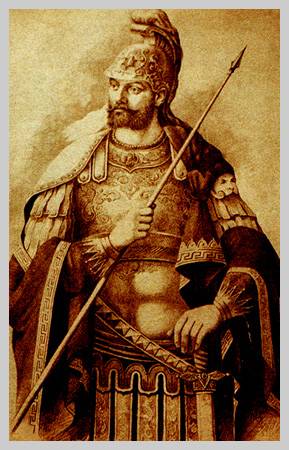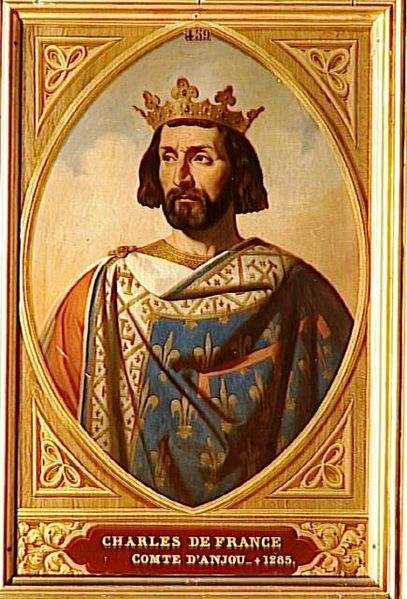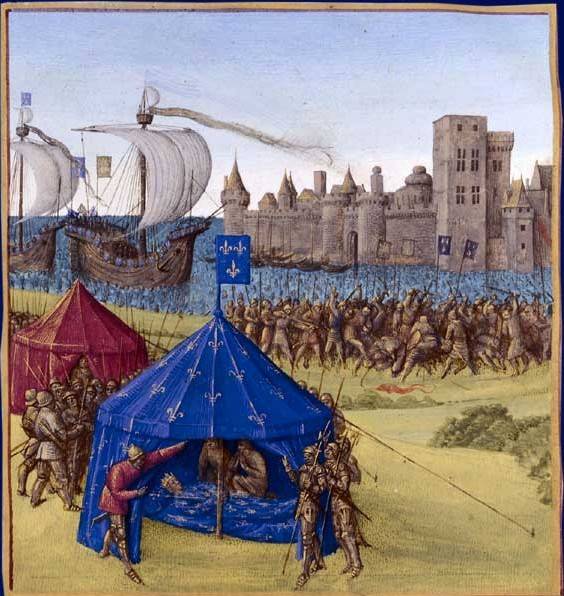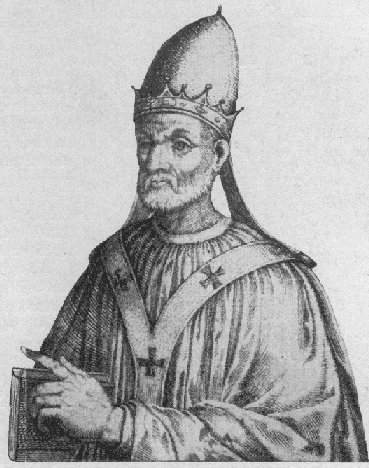II. Foundation of Christian states in the East;
III. First destruction of the Christian states (1144-87);
IV. Attempts to restore the Christian states and the crusade against Saint-Jean d’Acre (1192-98);
V. The crusade against Constantinople (1204);
VI. The thirteenth-century crusades (1217-52);
VII. FINAL LOSS OF THE CHRISTIAN COLONIES OF THE EAST (1254-91)
No longer aided by funds from the West, and rent by internal disorders, the Christian colonies owed their temporary salvation to the changes in Mussulman policy and the intervention of the Mongols. The Venetians drove the Genoese from Saint-Jean d’Acre and treated the city as conquered territory; in a battle where Christians fought against Christians, and in which Hospitallers were pitted against Templars, 20,000 men perished. In revenge the Genoese allied themselves with Michael Palæologus, Emperor of Nicæa, whose general, Alexius Strategopulos, had now no trouble in entering Constantinople and overthrowing the Latin Emperor, Baldwin II, 25 July, 1261. The conquest of the Caliphate of Bagdad by the Mongols (1258) and their invasion of Syria, where they seized Aleppo and Damascus, terrified both Christians and Mohammedans; but the Mameluke ameer, Bibars the Arbelester, defeated the Mongols and wrested Syria from them in September, 1260. Proclaimed sultan in consequence of a conspiracy, in 1260, Bibars began a merciless war on the remaining Christian states. In 1263 he destroyed the church at Nazareth; in 1265 took Cæsarea and Jaffa, and finally captured Antioch (May, 1268). The question of a crusade was always being agitated in the West, but except among men of a religious turn of mind, like St. Louis, there was no longer any earnestness in the matter among European princes. They looked upon a crusade as a political instrument, to be used only when it served their own interests. To prevent the preaching of a crusade against Constantinople, Michael Palæologus promised the pope to work for the union of the Churches; but Charles of Anjou, brother of St. Louis, whom the conquest of the Two Sicilies had rendered one of the most powerful princes of Christendom, undertook to carry out for his own benefit the Eastern designs hitherto cherished by the Hohenstaufen.
While Mary of Antioch, granddaughter of Amaury II, bequeathed him the rights she claimed to have to the crown of Jerusalem, he signed the treaty of Viterbo with Baldwin II (27 May, 1267), which assured him eventually the inheritance of Constantinople. In no wise troubled by these diplomatic combinations, St. Louis thought only of the crusade. In a parliament held at Paris, 24 March, 1267, he and his three sons took the cross, but, despite his example, many knights resisted the exhortations of the preacher Humbert de Romans. On hearing the reports of the missionaries, Louis resolved to land at Tunis, whose prince he hoped to convert to Christianity. It has been asserted that St. Louis was led to Tunis by Charles of Anjou, but instead of encouraging his brother’s ambition the saint endeavoured to thwart it. Charles had tried to take advantage of the vacancy of the Holy See between 1268 and 1271 in order to attack Constantinople, the negotiations of the popes with Michael Palæologus for religious union having heretofore prevented him. St. Louis received the embassy of the Greek emperor very graciously and ordered Charles of Anjou to join him at Tunis. The crusaders, among whom was Prince Edward of England, landed at Carthage 17 July, 1270, but the plague broke out in their camp, and on 25 August, St. Louis himself was carried off by the scourge. Charles of Anjou then concluded a treaty with the Mohammedans, and the crusaders reimbarked. Prince Edward alone, determined to fulfil his vow, and set out for Saint-Jean d’Acre; however, after a few razzias on Saracenic territory, he concluded a truce with Bibars.
The field was now clear for Charles of Anjou, but the election of Gregory X, who was favourable to the crusade, again frustrated his plans. While the emissaries of the King of the Two Sicilies traversed the Balkan peninsula, the new pope was awaiting the union of the Western and Eastern Churches, which event was solemnly proclaimed at the Council of Lyons, 6 July, 1274; Michael Palæologus himself promised to take the cross. On 1 May, 1275, Gregory X effected a truce between this sovereign and Charles of Anjou. In the meantime Philip III, King of France, the King of England, and the King of Aragon made a vow to go to the Holy Land. Unfortunately the death of Gregory X brought these plans to nought, and Charles of Anjou resumed his scheming. In 1277 he sent into Syria Roger of San Severino, who succeeded in planting his banner on the castle of Acre and in 1278 took possession of the principality of Achaia in the name of his daughter-in-law Isabelle de Villehardouin. Michael Palæologus had not been able to effect the union of the Greek clergy with Rome, and in 1281 Pope Martin IV excommunicated him. Having signed an alliance with Venice, Charles of Anjou prepared to attack Constantinople, and his expedition was set for April, 1283.
On 30 March, 1282, however, the revolt known as the Sicilian Vespers occurred, and once more his projects were defeated. In order to subdue his own rebellious subjects and to wage war against the King of Aragon, Charles was at last compelled to abandon his designs on the East. Meanwhile Michael Palæologus remained master of Constantinople, and the Holy Land was left defenceless. In 1280 the Mongols attempted once more to invade Syria, but were repulsed by the Egyptians at the battle of Hims; in 1286 the inhabitants of Saint-Jean d’Acre expelled Charles of Anjou’s seneschal and called to their aid Henry II, King of Cyprus. Kelaoun, the successor of Bibars, now broke the truce which he had concluded with the Christians, and seized Margat, the stronghold of the Hospitallers. Tripoli surrendered in 1289, and on 5 April, 1291, Malek-Aschraf, son and successor of Kelaoun, appeared before Saint-Jean d’Acre with 120,000 men.
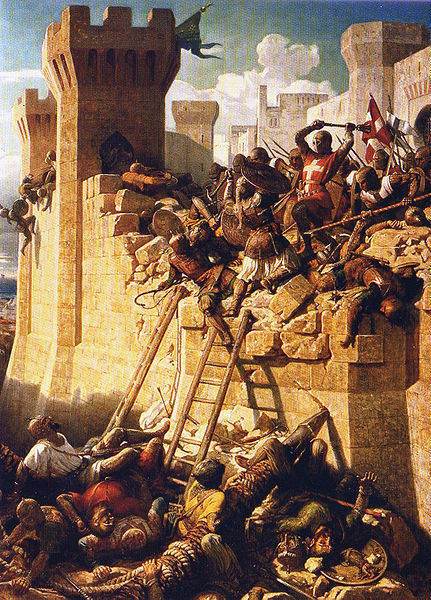
The Hospitaller grand master Guillaume de Clermont defending the walls at the Siege of Acre in 1291, by Dominique-Louis Papéty.
The 25,000 Christians who defended the city were not even under one supreme commander; nevertheless they resisted with heroic valour, filled breaches in the wall with stakes and bags of cotton and wool, and communicated by sea with King Henry II, who brought them help from Cyprus. However, 28 May, the Mohammedans made a general attack and penetrated into the town, and its defenders fled in their ships. The strongest opposition was offered by the Templars, the garrison of whose fortress held out ten days longer, only to be completely annihilated. In July, 1291, the last Christian towns in Syria capitulated, and the Kingdom of Jerusalem ceased to exist.
LOUIS BRÉHIER (Catholic Encyclopedia)
